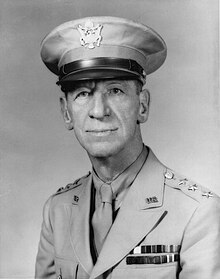Stanley Dunbar Embick
| Stanley Dunbar Embick | |
|---|---|

Stanley Dunbar Embick
|
|
| Born |
January 22, 1877 Greencastle, Pennsylvania |
| Died |
October 23, 1957 (aged 80) Walter Reed Army Medical Center |
| Place of burial | Arlington National Cemetery |
| Allegiance |
|
| Service/branch |
|
| Years of service | 1899–1941; 1942–1946 |
| Rank |
|
| Commands held |
IV Corps Third United States Army |
| Battles/wars |
Spanish–American War World War I World War II |
| Awards | Distinguished Service Medal (2) |
Stanley Dunbar Embick (January 22, 1877 – October 23, 1957) was a Lieutenant General in the United States Army.
Embick was born in Greencastle, Franklin County, Pennsylvania on January 22, 1877. He attended Dickinson College before enrolling at the United States Military Academy in West Point, New York, from which he graduated in 1899. Commissioned a Second Lieutenant of Artillery, he served in Cuba during the Spanish–American War. After the war he served in a variety of assignments, including the staff of the Coast Artillery School at Fort Monroe, Virginia and Assistant to the Chief of Artillery in Washington, D.C.
During World War I he served on the staff of the Supreme War Council, and then the Commission to Negotiate Peace, for which he received the Distinguished Service Medal.
In December, 1919 he was assigned to the staff of the War Department's War Plans Division, where he served until attending the Army War College. After serving as a War College instructor, Embick served in the Philippines, afterwards returning to Washington to serve as Executive Officer of the War Plans Division. In 1930 he became commandant of the Coast Artillery School.
In 1932 he was appointed commander of harbor defenses in the Philippines as a Brigadier General, where he was responsible for constructing Corregidor's Malinta Tunnel, which was used as a bomb-proof storage and personnel bunker and hospital during World War II, and is now the venue for a historical audio-visual presentation about the war.
Embick became Director of the War Plans Division as a Major General in 1936, and later that year was named the Army's Deputy Chief of Staff. He was appointed IV Corps commander in 1938, and later the same year took command of the Third Army as a Lieutenant General, where he served until his 1941 retirement.
...
Wikipedia
